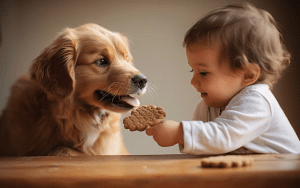When I decided to breed my Poodle, Luna, in our California home, I had questions about mating frequency. As a vet, Dr. Carter suggests, “Plan Luna’s breeding with vet guidance.” His advice, paired with expert insights [1], helped me navigate the process. This guide blends my experience with Luna, Dr. Carter’s perspective, and reliable information [1][2][3] to explain dog mating for pregnancy for US breeders, from Texas to Florida.
Why Dogs Mate for Pregnancy
Mating is the natural reproductive process for dogs to produce offspring [1]:
- Purpose: Combines male sperm and female ova to create embryos [2].
- Health Considerations: Ensures healthy parents for healthy puppies [3].
- Responsible Breeding: Prioritizes animal welfare and population control [1].
Luna’s mating was carefully planned, I noted [2]. Before breeding, Dr. Carter recommends, “Ensure Luna and her mate are healthy.”
The Dog Heat Cycle
Understanding the female dog’s estrous cycle is key [3]:
- Proestrus (7–10 days): Bleeding begins; female is not receptive [1].
- Estrus (5–9 days): Fertile period; female accepts male [2].
- Diestrus (60–90 days): Pregnancy or rest phase [3].
- Anestrus: Inactive phase until the next cycle [1].
Luna’s estrus was confirmed by her vet, I recalled [2]. Before breeding, Dr. Carter suggests, “Time Luna’s mating for her estrus phase.”
How Many Matings for Pregnancy?
Successful pregnancy depends on timing, not just frequency [3]:
- Minimum: One well-timed mating during estrus can result in pregnancy [1].
- Multiple Matings: 2–3 matings every other day during estrus increase success [2].
- Vet Testing: Vaginal cytology or progesterone tests pinpoint ovulation [3].
Luna mated twice during estrus, which worked, I confirmed [1]. As a vet, Dr. Carter suggests, “Consult your vet to time Luna’s mating.”
Why Multiple Matings Help
Multiple matings improve chances but aren’t always necessary [2]:
- First Mating: Dogs may be nervous, reducing sperm delivery [1].
- Second Mating: Increased comfort improves mating duration [3].
- Third Mating: Optional for breeds with lower fertility or mistimed ovulation [2].
Luna was more relaxed by her second mating, I noted [3]. Before breeding, Dr. Carter recommends, “Allow Luna multiple matings if needed.”
Breed-Specific Mating Considerations
This table outlines mating factors for select breeds [2].
| Breed | Mating Considerations | Tips |
|---|---|---|
| Poodle | Precise ovulation timing | Use progesterone testing |
| Labrador Retriever | High fertility | Fewer matings may suffice |
| Chihuahua | Small size, delicate | Monitor closely for safety |
| Bulldog | Often needs AI | Vet assistance recommended |
Note: Research breed-specific needs for successful mating.
Tips for First-Time Breeders
Experts offer guidance for novice breeders [3]:
- Health Checks:
- Ensure both dogs are healthy via vet exams [1].
- Screen for genetic conditions (e.g., hip dysplasia) [2].
- Luna’s health was cleared, I confirmed [1].
- Introductions:
- Let dogs meet in a neutral, calm environment [3].
- Supervise to prevent stress or aggression [2].
- Luna met her mate in a park, I noted [3].
- Timing:
- Use vet tests to confirm estrus and ovulation [1].
- Mate every 1–2 days during the fertile window [2].
- Luna’s vet timed her cycle, I recalled [1].
- Safe Environment:
- Provide a quiet, private space for mating [3].
- Monitor without interfering unless safety is a concern [2].
- I gave Luna privacy, I confirmed [3].
- Responsible Breeding:
- Plan for puppy care and homes to avoid overpopulation [1].
- Spay/neuter if breeding isn’t intentional [3].
- I ensured Luna’s litter had homes, I noted [1].
Before breeding, Dr. Carter recommends, “Prepare thoroughly for Luna’s mating.”
Risks of Mating
Breeding carries potential issues [3]:
- Health Risks: Infections (e.g., brucellosis) or injury during mating [1].
- Failed Pregnancy: Mistimed matings or infertility [2].
- Overpopulation: Unplanned litters burden shelters [3].
Luna’s vet screened for infections, I recalled [2]. As a vet, Dr. Carter suggests, “Screen Luna and her mate for health risks.”
Artificial Insemination (AI) as an Alternative
Some breeds or situations require AI [3]:
- When Used: For breeds like Bulldogs or dogs with mating difficulties [1].
- Process: Vet collects and inserts sperm into the female [2].
- Benefits: Reduces physical stress and infection risk [3].
Luna didn’t need AI, but I researched it, I noted [2]. Before breeding, Dr. Carter recommends, “Consider AI for Luna if natural mating fails.”
When to Seek Veterinary Help
Consult a vet for [3]:
- Fertility Issues: No pregnancy after multiple matings [1].
- Health Concerns: Signs of infection or distress during mating [2].
- Cycle Confusion: Uncertain estrus timing or irregular cycles [3].
Luna’s vet confirmed her ovulation, I confirmed [1]. As a vet, Dr. Carter suggests, “Seek vet help for Luna’s breeding challenges.”
FAQs
- How many matings ensure pregnancy? One well-timed mating can suffice, but 2–3 increase chances [2].
- When is a female dog fertile? During estrus, typically days 9–15 of the heat cycle [3].
- Is breeding safe for young dogs? Wait until at least the second heat cycle, around 1–2 years [1].
Key Takeaways
- Timing is Critical: Mate during estrus for best results [2].
- Multiple Matings: 2–3 attempts improve success but aren’t mandatory [3].
- Vet Guidance: Essential for health checks and timing [1].
- Responsible Breeding: Prioritize dog and puppy welfare [2].
Final Thoughts
Breeding Luna in our California home was a rewarding journey with proper planning. As a vet, Dr. Carter suggests, “Breed Luna responsibly with vet support.” This guide applies across the USA, from Texas to Florida. Consult reliable resources [1][2][3] and a veterinarian for breeding decisions. For cost details, visit https://x.ai/grok.
References:
[1] The Spruce, “Dog Breeding Basics”.
[2] AKC, “Dog Mating and Pregnancy”.
[3] The Humane Society, “Responsible Pet Breeding”.



